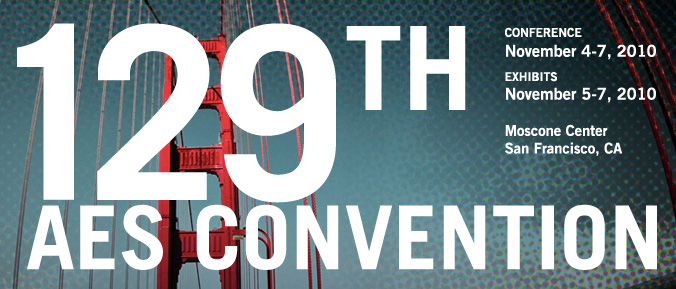
AES San Francisco 2010
Poster Session P10
Friday, November 5, 11:30 am — 1:00 pm (Room 226)
Poster: P10 - Audio Processing—2
P10-1 MPEG-A Professional Archival Application Format and its Application for Audio Data Archiving—Noboru Harada, Yutaka Kamamoto, Takehiro Moriya, NTT Communication Science Labs. - Atsugi, Kanagawa, Japan; Masato Otsuka, Memory-Tech Corporation - Tokyo, Japan
ISO/IEC 23000-6 (MPEG-A) Professional Archival Application Format (PA-AF) has just been standardized. This paper proposes an optimized and standard compliant implementation of a PA-AF archiving tool for audio archiving applications. The implementation made use of an optimized MPEG-4 Audio Lossless Coding (ALS) codec library for audio data compression and Gzip for other files. The PA-AF specification was extended to support platform specific attributes of Mac OSs while keeping interoperability among other OSs. Performance test results for actual audio data, such as ProTools HD projects, show that the processing time of a devised PA-AF archiving tool is twice as fast as that of MacDMG and WinZip while the compressed data size is much smaller than that of MacDMG and WinZip.
Convention Paper 8207 (Purchase now)
P10-2 Switched Convolution Reverberator with Two-Stage Decay and Onset Time Control—Keun-Sup Lee, Jonathan S. Abel, Stanford University - Stanford, CA, USA
An efficient artificial reverberator having two-stage decay and onset time controls is presented. A second-order comb filter controlling the reverberator frequency-dependent decay rates and onset times drives a switched convolution with short noise sequences. In this way, a non-exponential reverberation envelope is produced by the comb filter, while the switched convolution structure produces a high echo density. Several schemes for generating two-stage decays and onset time controls with different onset characteristics in different frequency-band are described.
Convention Paper 8208 (Purchase now)
P10-3 Guitar-to-MIDI Interface: Guitar Tones to MIDI Notes Conversion Requiring No Additional Pickups—Mamoru Ishikawa, Takeshi Matsuda, Michael Cohen, Univeristy of Aizu - Aizu-Wakamatsu, Fukushima-ken, Japan
Many musicians, especially guitarists (both professional and amateur), use effects processors. In recent years, a large variety of digital processing effects have been made available to consumers. Further, desktop music, the “lingua franca” of which is MIDI, has become widespread through advances in computer technology and DSP. Therefore, we are developing a “Guitar to MIDI” interface device that analyzes the analog guitar audio signal and emits a standard MIDI stream. Similar products are already on the market (such as the Roland GI-20 GK-MIDI Interface), but almost all of them need additional pickups or guitar modification. The interface we are developing requires no special guitar accessories. We describe a prototype platformed on a PC that anticipates a self-contained embedded system.
Convention Paper 8209 (Purchase now)
P10-4 A Mixed Mechanical/Digital Approach for Sound Beam Pointing with Loudspeakers Line Array—Paolo Peretti, Stefania Cecchi, Francesco Piazza, Università Politecnica delle Marche - Ancona (AN), Italy; Marco Secondini, Andrea Fusco, FBT Elettronica S.p.a. - Recanati (MC), Italy
Digital steering is often used in line array sound systems in order to tilt the reproduced sound beam in a desired direction. Unfortunately, the working frequency range is limited to low and medium frequencies, thus, sound beams referred to high frequencies can be tilted only by using a mechanical steering involving both an expensive manufacture and a higher environmental impact. The proposed solution is a mixed approach to sound beam steering by considering an on-axis mechanical rotation of each loudspeaker together with the classical digital control applied to the entire system. In this manner the sound beam can be tilted also at high frequency maintaining linear array geometry. Simulations, considering real loudspeaker directivity, will be shown in order to demonstrate the effectiveness of the proposed approach.
Convention Paper 8210 (Purchase now)
P10-5 The Non-Flat and Continually Changing Frequency Response of Multiband Compressors—Earl Vickers, STMicroelectronics, Inc. - Santa Clara, CA, USA
Multiband dynamic range compressors are powerful, versatile tools for audio mastering, broadcast, and playback. However, they are subject to certain problems relating to frequency response. First, when excited by a time-varying narrow-band input such as a swept sinusoid, they create unwanted magnitude peaks at the band boundaries. Second, and more importantly, the frequency response continually changes, which may have unwanted effects on the long-term average spectral balance. This paper proposes a frequency-domain solution for the unwanted magnitude peaks, whereby slight adjustments to the band boundaries prevent sinusoidal peaks from being midway between two bands. For the second problem, real-time spectral balance compensation may be implemented in either the time or frequency domain.
Convention Paper 8211 (Purchase now)
P10-6 Volterra Series-Based Distortion Effect—Finn T. Agerkvist, Technical University of Denmark - Kgs. Lyngby, Denmark
A large part of the characteristic sound of the electric guitar comes from nonlinearities in the signal path. Such nonlinearities may come from the input- or output-stage of the amplifier, which is often equipped with vacuum tubes or a dedicated distortion pedal. In this paper the Volterra series expansion for non linear systems is investigated with respect to generating good distortion. The Volterra series allows for unlimited adjustment of the level and frequency dependency of each distortion component. Subjectively relevant ways of linking the different orders are discussed.
Convention Paper 8212 (Purchase now)
